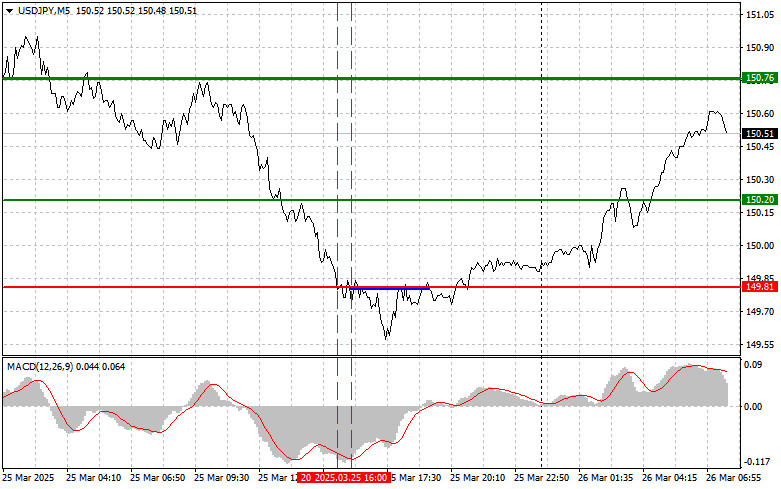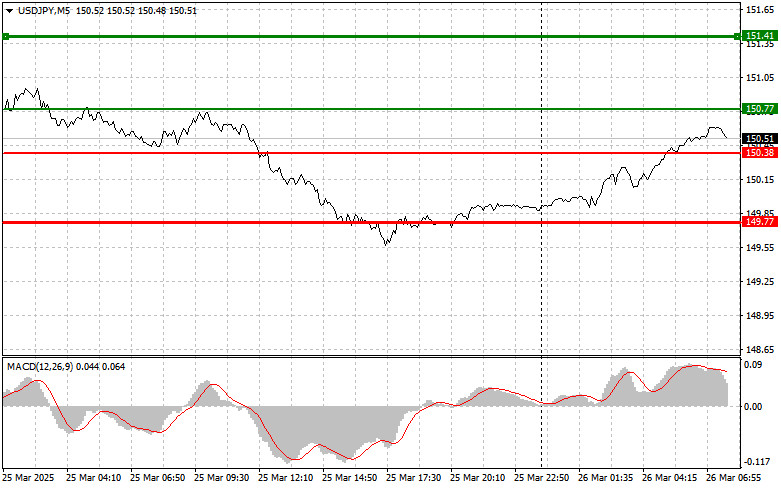Analysis of Trades and Trading Tips for the Japanese Yen
The test of the 149.81 level occurred when the MACD indicator had already moved significantly below the zero line, which limited the pair's downside potential. For this reason, I didn't sell the dollar. The second test of 149.81, when the MACD was in the oversold zone, provided a basis for executing Scenario #2 for a buy. However, as seen on the chart, a strong upward move never materialized, so extracting a profit from this trade was difficult.
Today, Bank of Japan Governor Kazuo Ueda stated that he intends to keep interest rates unchanged ahead of the bank's next monetary policy meeting while traders were looking for hints on the timing of the next rate hike. This negatively impacted the yen and helped the dollar strengthen. In presenting the bank's semiannual report to lawmakers, Ueda reiterated the BoJ's stance that it would continue raising interest rates if its economic outlook plays out but refrained from giving any specific signals about when the central bank might hike rates again. He also noted an upward trend in prices, though he mentioned that it has not yet reached the 2% inflation target the bank aims for.
This suggests that the yen's weakening trend against the dollar may persist in the near term, so be cautious when selling USD/JPY—do so from as high as possible.
Buy Signal
Scenario #1: I plan to buy USD/JPY today at the entry point around 150.77 (green line on the chart) with a target of 151.41 (thicker green line). Around 151.41, I plan to exit long positions and open short positions in the opposite direction (expecting a 30–35 pip pullback). It's best to return to buying the pair during corrections and significant drawdowns. Important: Before buying, ensure the MACD indicator is above the zero line and beginning to rise.
Scenario #2: I also plan to buy USD/JPY today in case of two consecutive tests of the 150.38 level while the MACD is in the oversold zone. This would limit the pair's downside potential and trigger an upward reversal. A rise toward the opposite levels of 150.77 and 151.41 can be expected.
Sell Signal
Scenario #1: I plan to sell USD/JPY only after a break below 150.38 (red line on the chart), which will likely lead to a sharp decline. The key target for sellers will be 149.77, where I plan to exit short positions and immediately open long positions in the opposite direction (expecting a 20–25 pip rebound). Downward pressure may return at any moment. Important: Before selling, ensure the MACD indicator is below the zero line and beginning to fall from it.
Scenario #2: I also plan to sell USD/JPY today in case of two consecutive tests of the 150.77 level while the MACD is in the overbought zone. This would limit the pair's upward potential and trigger a downward reversal. A decline toward the opposite levels of 150.38 and 149.77 can be expected.
What's on the Chart:
- The thin green line represents the entry price where the trading instrument can be bought.
- The thick green line indicates the expected price level where a Take Profit order can be placed, or profits can be manually secured, as further price growth above this level is unlikely.
- The thin red line represents the entry price where the trading instrument can be sold.
- The thick red line indicates the expected price level where a Take Profit order can be placed, or profits can be manually secured, as further price decline below this level is unlikely.
- The MACD indicator should be used to assess overbought and oversold zones when entering the market.
Important Notes:
- Beginner Forex traders should exercise extreme caution when making market entry decisions. It is advisable to stay out of the market before the release of important fundamental reports to avoid exposure to sharp price fluctuations. If you choose to trade during news releases, always use stop-loss orders to minimize potential losses. Trading without stop-loss orders can quickly wipe out your entire deposit, especially if you neglect money management principles and trade with high volumes.
- Remember, successful trading requires a well-defined trading plan, similar to the one outlined above. Making impulsive trading decisions based on the current market situation is a losing strategy for intraday traders.






















